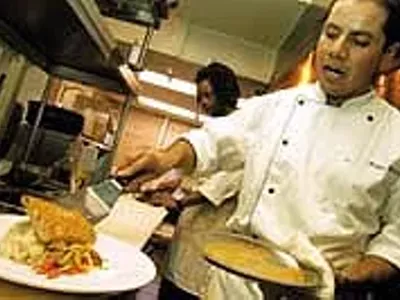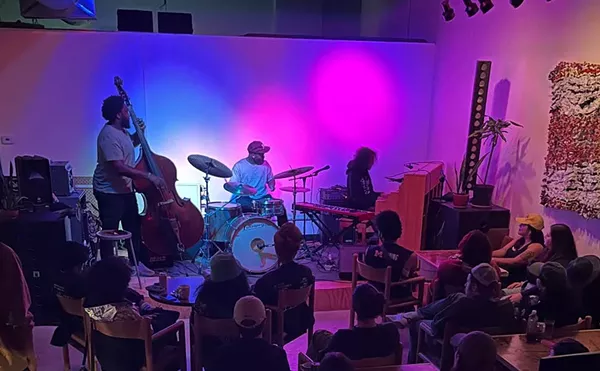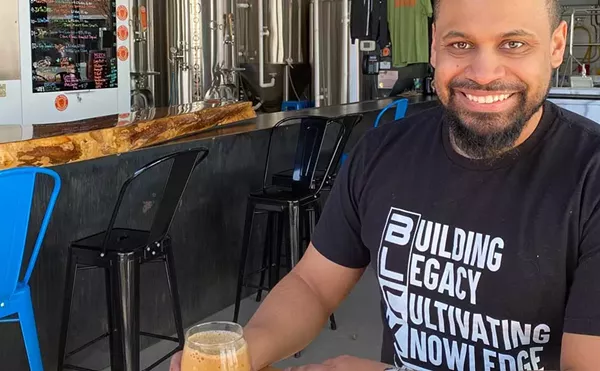Then there are those, such as chef Takashi Yagihashi of the dizzyingly upscale Tribute restaurant in Farmington Hills, who bring multilevels of awareness and sensitivity to their work. Takashi simply thinks of it as a form of respect:
"I’m not going to put together two totally different things in one place. I’m going to use Japanese ingredients, like vegetables or some fish coming from Japan, and then cook with the French technique. I won’t try totally surf-and-turf things, like some people do, because I respect French culture, Japanese culture and also American culture too."
Takashi directs a large staff of culinary experts in the Tribute kitchen which is downstairs beneath the sumptuous dining room, but which also includes a few elegantly appointed tables for those who wish to dine where the real action is. Runners, not elevators, take the food up to the ground floor. "It’s faster that way," says the master chef "and the food stays just right."
As he gets ready to concoct a dish of roasted Atlantic halibut, the bustle of activity around Takashi is unrelenting, though it’s afternoon prep time and dinner still is hours away. At the center of the storm, he is calm, mild-mannered, mellow — and his eyes light up with obvious pleasure as he works.
"I’m trying to express myself on the plate, but I’m always careful to remember there’s a reason why I’m doing this. I just don’t do it because ‘this sounds cool or this looks good.’
"This halibut is a very traditional French dish, but I’ve changed it a little. The French usually make the brown butter with lots of capers and lemon juice. I use the exactly same technique, but instead of capers I use pumpkin seeds. It’s October and getting cold with crispy air, so I want to eat something earthier than in summertime. There’s the mushrooms’ earthiness and the sweetness of squash — then something crispy and crunchy with the pumpkin seeds. And nice, beautiful fish from the Atlantic Ocean — the halibut."
Although this is one of Takashi’s simpler recipes, the various stages and facets intersect in a rendezvous that’s a little like the meeting of a shuttle rocket and a space station in orbit — dependant on much forethought and timing. For instance, the squash needs to start roasting 20 minutes before it welcomes the shallots, garlic and spinach, which come in for a landing one after the other and then stay warm, biding their time until they all turn into a bed for the fish.
Takashi wields the skillet in the same way that he places the halibut on the vegetables — with grace and care — like a Zen craftsman turning the most familiar task into a wonder of mindfulness. After he drizzles the brown butter over his creation, he tops it off with two slices of white truffle — a detail that takes it all to another level (to coin a phrase).
"I love fish. Where I grew up in Japan was just 10 miles from the Pacific Ocean shore — in a town named Mito — and fish was one of the cheapest things. McDonald’s was more expensive than fish. So my parents fed me a lot of fish and I grew up with it. Now my favorites are bluefish, mackerel, sardines — the fattier kinds — but also whitefish like halibut."
Takashi learned to cook as a 16-year-old apprentice in a neighbor’s restaurant close to his house in Mito.
"I just wanted to make extra money, so I worked there after school. But I never thought of being a chef. When I was growing up in Japan, chefs were thought of as kind of losers, not respectable. Now it’s so different. People ask me, ‘Hey Takashi, can I have your autograph?’ In the last 20 years, here and in Japan, it’s totally changed."
At 18, Takahashi studied interior design in Tokyo, a discipline that seems to inflect the intense visual beauty of his dishes. But after he traveled to the United States to work in Japanese restaurants in Chicago, he began to study with chef Yoshi Katsumura of Yoshi’s Café. It was this master who introduced him to the respectful and subtle kind of "fusion" that he now practices, one that involves a deep understanding of specific cuisines and their traditions.
"There’s a very traditional Japanese tasting menu, from the 17th and 18th century tea ceremony, which includes eight or nine courses of small, bite-sized portions. At Tribute we do three menus: One is the à la carte, in which you start with an appetizer, then a main course and dessert — for that one I make larger portions. But the Atlantic halibut portion I made today is about the same size as for our tasting menus."
Tribute has two of these, called "Degustations." One features a succession of such plates as "Sashimi of Seared Bluefin Tuna & East Coast Fluke (with sweet onion-soy dressing)" and "Grilled-Herb Marinated Colorado Rack of Lamb (with almond custard, ratatouille, couscous, eggplant caviar, pesto and tapenade)." The other, devoted to vegetables, offers the likes of "Roasted Eggplant Soup (with fennel, red pepper and onion)" and "Risotto of Wild Mushrooms and Summer Truffles (with asparagus, baby spinach, roasted garlic, haricot vert and truffle-corn foam)."
"I like the tasting menus," says Takashi, "because I don’t like big portions. In a tasting menu, you can appreciate the different textures, flavors and colors — so you can enjoy more than if you only had one big dish."
But whatever the size or scale, Chef Takashi focuses on the integrity of the experience, how ingredients have always been used and the ways he can alter those ever so subtly in the service of the sublime.
Chef Takashi Yagihashi's recipe for Roasted Atlantic halibut
Tribute is at 31425 W. 12 Mile Road, Farmington Hills. Call 248-848-9393 or go to www.tribute-restaurant.com.
Read other chefs' stories in Chow!! (this week's special restaurant collection):
• Mind-morphing means sweet surrender to Agave's chef Carlos Bonilla.
• Laurent Devin keeps the Gallic fires burning at Elaine Bistro Français.
• Udipi's Thilagam Pandian cooks her way to places of the heart.
• Loving Spoonful ladles out the full flavor of Shawn Loving's approach.
George Tysh is the arts editor of Metro Times. E-mail [email protected]






